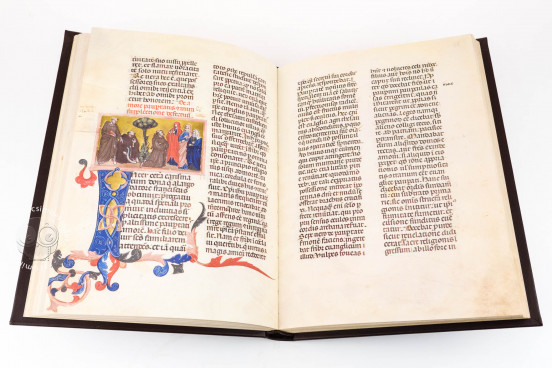On April 16, 1209, Pope Innocent III granted his approval to the formula vitae by which Saint Francis of Assisi and his confreres vowed to live in poverty, obedience and chastity, following the doctrine and the example of Jesus Christ. This was the approval of the "Franciscan Rule" which marked the birth of the Order that this year celebrates its eight-hundredth anniversary.
The legend of a Saint
The Manuscript is the most important illuminated codex of the Biblioteca Nazionale Centrale di Roma, and contains one of the oldest and most precious drafts of the Legenda maior sancti Francisci, the official biography of the Saint from Assisi written by Saint Bonaventure of Bagnoregio on commission of the Order of Friars Minor and approved by the General Chapter of Pisa in 1263.
The Vittorio Emanuele 411 Codex was made in the XIV century, about a century after Bonaventure had written the Legenda Maior, and contains the complete text. Larger in size than the other codices of the Legenda, and written in a regular littera textualis, it is richly decorated with an abundance of illuminated initials and seventeen images depicting episodes from the Saint’s life on gold ground, and is indeed a rarity, considering how few illuminated codices of the Legenda come from this period.
A different format for a unique book
Its different and larger format, compared to the other smaller ones intended as handbooks, would seem to be that of a library codex but, unfortunately, its exact origin is not known. According to scholars, however, it should be attributed to the Emilia-Romagna area and, in all probability, was commissioned by a wealthy patron; a kneeling female figure indeed appears several times in some of the miniatures.
The text begins with the Prologue in which Bonaventure praises Francis’ sanctity and salvific mission, sealed by the stigmata, illustrates the reasons that drove him to write of his life, and explains that he has not organised the tale according to a chronological sequence but instead grouping the episodes belonging to the same theme.
Then follows the Saint’s Life, divided into fifteen chapters, each of which begins with an illuminated vignette illustrating a theme or an episode of the text, as in Saint Bonaventure’s text, with few exceptions following Giotto’s fresco cycle of the Life of Saint Francis in the Upper Basilica of Assisi. The last chapter, entitled In festo translationis beati Francisci, is divided into nine lections to recite on the occasion of the Saint’s feast day.
We have 1 facsimile edition of the manuscript "Rome Life of Saint Francis": San Francesco - Legenda Maior facsimile edition, published by Vallecchi, 2009
Request Info / Price















